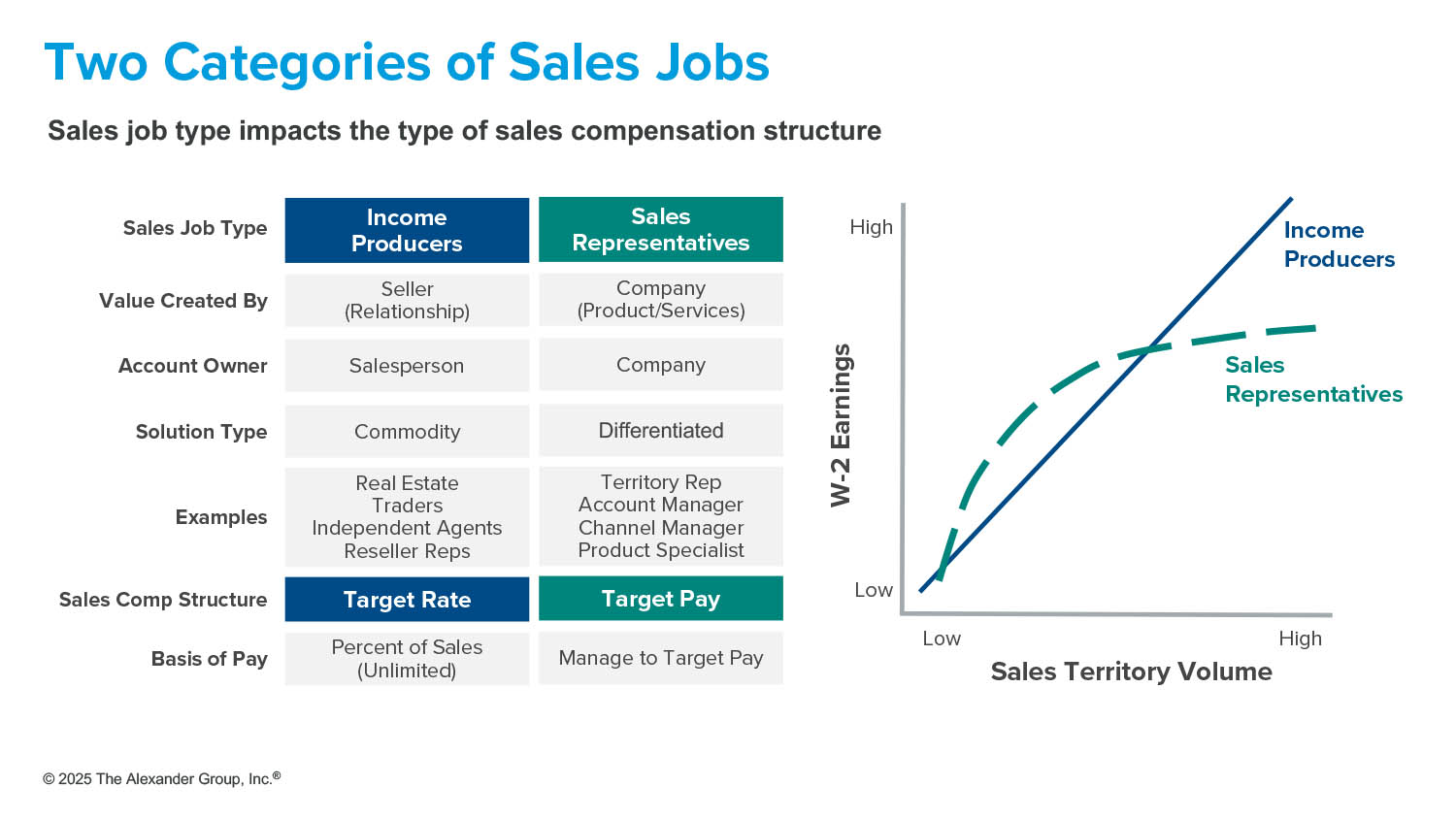For WorldatWork Members
- How to Navigate Tariff Uncertainty with a Responsive Sales Comp Strategy, Workspan Magazine article
- Sales Performance Management, research
- Sales Compensation Programs and Practices, research
- Sales Compensation Plan: Organizational Inventory, tool
For Everyone
- Bookings vs. Revenue: A Sales Compensation Crediting Conundrum, Workspan Daily article
- The Checkup: Diagnosing and Optimizing Your Sales Compensation Program, Workspan Daily article
- Winning Big: Incentive Strategies for Megadeal Sellers, Workspan Daily article
- Pursuing a Career in Sales Compensation? Here Are 5 Suggestions, Workspan Daily article
- Sales Compensation Course Series, education
Sales designers need to be aware that the marketplace uses two types of sales job archetypes: income producer and sales representative. Each job type will dictate the appropriate compensation plan structure as well as the proper compensation solutions to drive strategic focus and productivity improvements.
In an income producer model, the products are a commodity — meaning, the customer buys a company’s products primarily based on their relationship with the seller. Thus, the seller “owns” the customer relationship and can bring their customer with them if they leave the company. Sellers in the income producer model are paid a flat commission rate (100% commission) that is usually set by the industry/market. Examples of income producer jobs include real estate agents, mortgage brokers, agents and reseller representatives.
In a sales representative model, the seller represents the company’s products. The customer buys from the company due to the firm’s differentiation solution, which could be its features, benefits, expertise and/or value-added services. In this model, the company “owns” the customer relationship even if the seller leaves the company. Since sellers represent the company’s products in this model, they are paid a target pay level (base salary plus a target incentive) according to market benchmarks — just like most any other functional job in an organization (e.g., human resources, finance, operations). Most sales jobs in the marketplace are sales representative job types.
The figure below articulates these two models and their impact on pay. Income producers use a cost-of-sales model that keeps these employees earning at the same rate regardless of their performance. Sales representatives use a cost-of-labor model that provides these employees a market pay rate that roughly correlates to various performance levels.

Income Producer Model
Since the market and industry typically dictate the rate in an income producer model, there are a limited number of sales compensation solutions that management can use to drive strategic priorities and higher productivity.
|
Driving Strategic Priorities | ||
|
Method |
Example |
Pro Tip |
|
Product-specific rates |
Provide a 2% commission rate for core products and a 4% commission rate for strategic products. |
Limit the number of product categories with different rates to ensure sellers focus on all of them. |
|
Sales performance incentive funds (SPIFs) |
Provide extra short-term incentives for specific products. |
Limit the amount of pay with SPIFs so they do not dilute the core sales compensation plan. |
|
Driving Higher Productivity | ||
|
Method |
Example |
Pro Tip |
|
Ramped rates based on volume |
Provide a 2% commission rate for all sales less than $1 million and a 4% commission rate for all sales greater than $1 million. |
Ensure ramped rates do not unfairly favor sellers with larger territories or territories with higher potential. |
|
Year-end performance bonus |
Provide an extra 1% commission or a $10,000 bonus if the seller achieves $1 million in performance. |
Ensure the additional expense is justified by the outcomes. |
There are many challenges driving seller focus and growth with income producers. It is hard to drive sales growth with tenured sellers who earn a comfortable income level off their annuity run-rate business. Moreover, it is very challenging to make any plan or rate changes. This is because income producers can switch companies and take their customers with them if they dislike those changes.
Sales Representative Model
Since sales representatives have a target incentive that is typically contingent upon achieving assigned quotas for measures outlined in their plan, there are multiple methods to drive strategic priorities and productivity improvements.
|
Driving Strategic Priorities | ||
|
Method |
Example |
Pro Tip |
|
Separate measure |
Provide a separate weighted product-focused measure (e.g., 25% strategic product measure). |
Consider variance in strategic product opportunity across sellers when creating a separate measure. |
|
Hurdle (gate) |
Provide a higher accelerator (such as 3 times versus 2 times) on a total measure if the seller achieves a strategic product quota. |
Use a richer accelerator (i.e., carrot) if rewarding new behaviors or a lower/no accelerator (i.e., stick) if communicating a minimum performance expectation. |
|
Credit uplifts and downlifts |
Provide a 2x credit uplift for new products and a 0.5x credit downlift for legacy products. |
Limit the amount of credit uplifts to a small percent of business so it does not impact the quota-setting methodology. |
|
Add-on bonus |
Provide an on-top flat bonus or commission rate for secondary focus areas. |
Limit add-on bonuses to minimize excessive expenses. |
|
SPIFs |
Provide extra short-term incentives for specific products. |
Limit the amount of pay with SPIFs so they do not dilute the core sales compensation plan. |
|
Double quota/double credit |
Provide an overlay product specialist with a product quota that represents a rollup of the sellers they support. |
Ensure overall quotas incorporate higher productivity expectations via the use of the overlay specialists. |
|
Driving Higher Productivity | ||
|
Method |
Example |
Pro Tip |
|
Higher quotas |
Increase year-over-year quotas by 10%. |
Vary the increase up and down for individuals based on their territory’s sales potential. |
|
Accelerated rates |
Provide a 2x accelerator for achieving quota. |
Calculate accelerator rates by dividing the desired upside pay by the expected above-quota performance for the 90th-percentile performer (e.g., 200% of target incentive upside divided by 100% of above-quota performance = 2x). |
|
Thresholds |
Do not provide any pay unless the seller achieves 50% of their quota. |
Set the threshold based on the percentage of reoccurring revenue that requires no/less persuasion and/or the achievement of the bottom 10% of sellers. |
It is generally easier to make plan design changes in the sales representative model. A guiding principle to use when communicating a plan change is “commit to the money and not the mechanics.” Specifically, commit to providing market-competitive target pay and upside. However, leaders should share that the measures and mechanisms may vary annually based on the company’s strategic priorities. Of course, companies must recognize sales representatives are human and can only accept so much change at a time.
Migrating to a Sales Representative Model
Some companies have successfully added differentiated services and solutions alongside their commodity products to migrate customer ownership from the seller to the company. These organizations then go through the daunting task of migrating their sales compensation program from commission rate plans to targeted pay/quota-based plans. This transformation typically requires setting targeted pay levels, creating a quota program, and building new sales compensation plans that leverage all the various mechanisms to drive strategic priorities and higher productivity. The most challenging part is creating the transition plan and moving the sales team to the new plan. Once this transformation is complete, these organizations — in most cases — see long-term, sustainable growth.
Editor’s Note: Additional Content
For more information and resources related to this article, see the pages below, which offer quick access to all WorldatWork content on these topics:
#1 Total Rewards & Comp Newsletter
Subscribe to Workspan Weekly and always get the latest news on compensation and Total Rewards delivered directly to you. Never miss another update on the newest regulations, court decisions, state laws and trends in the field.








